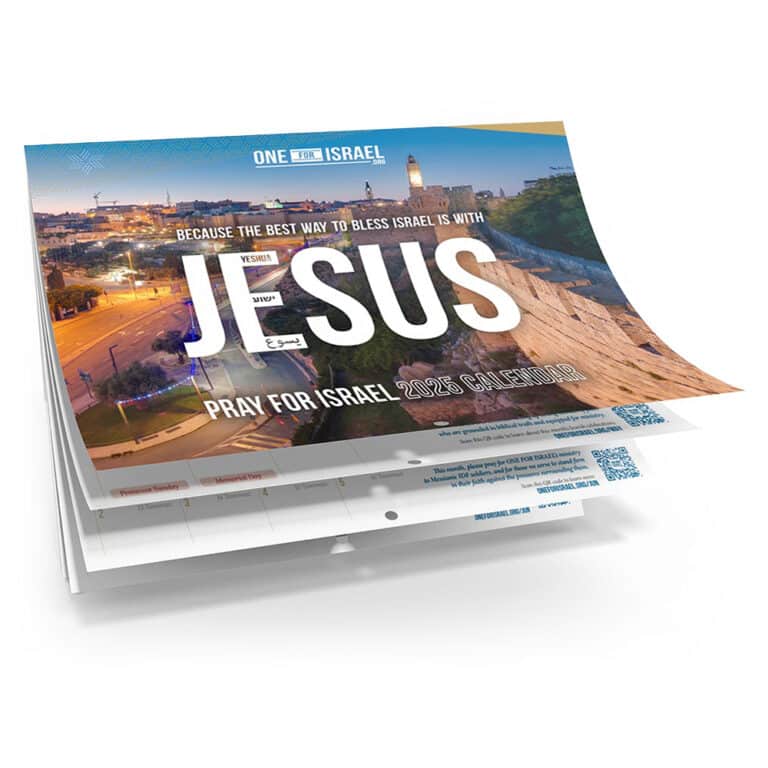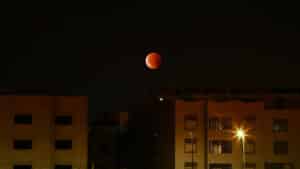You may have heard rumors about red heifers in Israel: hushed whispers of cattle kept in secret locations and clandestine sacrifices near the Temple Mount… or perhaps you even saw the statement by Hamas a little while ago that it was these red heifers that precipitated “Operation Al Aqsa Flood”. That’s right, apparently the mere existence of some red cows in Israel triggered the October 7 massacre according to a Hamas spokesman.
The Middle East is a wild place, and this is about as mad as it gets, but when we take a closer look at the biblical origins of this whole heifer debacle, you’ll see why it’s all so significant. Significant enough to start a war.
Red heifers in the Bible
Now the Lord spoke to Moses and to Aaron, saying, “This is the statute of the law that the Lord has commanded: Tell the people of Israel to bring you a red heifer without defect, in which there is no blemish, and on which a yoke has never come”. (Numbers 19:1-2)
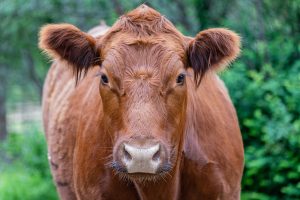 God’s law, given to the people of Israel at Mount Sinai, included the requirement of perfect red heifers. No defects, no blemishes. The unyoked, flawless heifers become “unkosher” once hairs are spotted that are not uniformly red. They have to be perfect. What happens to these red heifers? Their fate is not good, at least from the cows’ point of view. They are incinerated in complete totality, even including their dung. However, their death brings life. The ashes of the red heifer were required for proper priestly sacrifices to be made, in order to make atonement for sin.
God’s law, given to the people of Israel at Mount Sinai, included the requirement of perfect red heifers. No defects, no blemishes. The unyoked, flawless heifers become “unkosher” once hairs are spotted that are not uniformly red. They have to be perfect. What happens to these red heifers? Their fate is not good, at least from the cows’ point of view. They are incinerated in complete totality, even including their dung. However, their death brings life. The ashes of the red heifer were required for proper priestly sacrifices to be made, in order to make atonement for sin.
“And you shall give it to Eleazar the priest, and it shall be taken outside the camp and slaughtered before him. And Eleazar the priest shall take some of its blood with his finger, and sprinkle some of its blood toward the front of the tent of meeting seven times. And the heifer shall be burned in his sight. Its skin, its flesh, and its blood, with its dung, shall be burned.
And the priest shall take cedarwood and hyssop and scarlet yarn, and throw them into the fire burning the heifer.
 Then the priest shall wash his clothes and bathe his body in water, and afterward he may come into the camp. But the priest shall be unclean until evening. The one who burns the heifer shall wash his clothes in water and bathe his body in water and shall be unclean until evening. And a man who is clean shall gather up the ashes of the heifer and deposit them outside the camp in a clean place. And they shall be kept for the water for impurity for the congregation of the people of Israel; it is a sin offering.” (Numbers 19:3-9)
Then the priest shall wash his clothes and bathe his body in water, and afterward he may come into the camp. But the priest shall be unclean until evening. The one who burns the heifer shall wash his clothes in water and bathe his body in water and shall be unclean until evening. And a man who is clean shall gather up the ashes of the heifer and deposit them outside the camp in a clean place. And they shall be kept for the water for impurity for the congregation of the people of Israel; it is a sin offering.” (Numbers 19:3-9)
Today this passage about the red heifers is read in synagogues in the lead up to Passover, since it concerns ritual cleansing. The portion of Scripture in Numbers 19 relates to this cleansing issue, as those going up to make sacrifices could only do so if they had been cleansed by water mixed with the ashes of a perfect red heifer. Ever since the temple was destroyed by the Romans, this passage is read as part of the Passover preparations.
For the unclean they shall take some ashes of the burnt sin offering, and fresh water shall be added in a vessel. Then a clean person shall take hyssop and dip it in the water and sprinkle it on the tent and on all the furnishings and on the persons who were there and on whoever touched the bone, or the slain or the dead or the grave. And the clean person shall sprinkle it on the unclean on the third day and on the seventh day. Thus on the seventh day he shall cleanse him, and he shall wash his clothes and bathe himself in water, and at evening he shall be clean. (Numbers 19:17-19)
The ashes of the perfect red heifer go into a vessel with fresh water, and this water of purification cleanses from sin and death.
Rabbinic tradition
What might be slightly surprising is that according to the Bible, those involved in every stage of the production of these ashes, including those distributing them to make others ritually clean, become unclean by virtue of doing so.
The ashes of the heifer purify the contaminated and contaminate the pure.
As it says in ancient Jewish literature (Midrash Tanchuma):
The clean person shall sprinkle upon the unclean person . . . and he shall be clean at evening. . . [But] he who sprinkles the water of sprinkling . . . shall be unclean (Numbers 19:19–21) All who are involved in the preparation of the heifer, from beginning to the end, become impure, but the heifer itself purifies the impure! But G‑d says: I have made a chok, decreed a decree, and you may not transgress My decrees.
Midrash Tanchuma also contains the statement that the red heifer in a way atones for the golden calf, meaning that the ashes of red heifers have atoning power over sin, such as the sin of idolatry. It’s thought to be for this reason that Eleazar the priest is the one who first has to sprinkle the blood towards the sanctuary, not his father Aaron who was complicit in the golden calf incident: “Because Aharon made the calf, this service was not performed through him, for the prosecution cannot serve as the defense,” as it says in Midrash Aggadah. A ritually clean kohen or priest is not required to carry out the slaughter, but only the distribution of the blood and the water of purification.
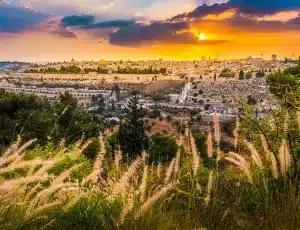
According to the Bible, the red heifers had to be burned “outside the camp” as the priest is described in Numbers 19:7 as coming back into the camp with the ashes. So this perfect specimen had to be killed outside the camp, and its death brought atonement and life in the place of sin and death, breaking the curse of death. Sound familiar?
Rabbinic commentary elaborates to specify three camps: it must be outside the camp of the Divine Presence, outside the Levite camp, and just to be on the safe side, outside the Israelite camp as well. In Tractate Yoma of the Talmud, which primarily deals with matters concerning the Day of Atonement, it’s explained that “outside the camp” means east of Jerusalem:
With regard to the red heifer, “outside the camp” (Numbers 19:3) just as here, it is burned outside three camps, so too there the heifer, it is burned outside three camps. And just as there it is burned east of Jerusalem, since the heifer must be burned “toward the front of the Tent of Meeting” (Numbers 19:4) – Yoma 68a
Due to this tradition, red heifers could be sacrificed on the Mount of Olives, which is east of the Temple Mount, and outside the walls of the city.1 We read in rabbinic commentary that in later generations, when this rite was to be performed outside the Temple in Jerusalem, the priest should stand to the east of Jerusalem and “direct his gaze toward the entrance to the Temple” while sprinkling the blood (Sifrei Chukath 14). So as long as the Temple Mount is in eyeshot, the red heifer can be sacrificed anywhere on the Mount of Olives. The Mount of Olives is also called Har HaMishkah (the Mount of Anointing) and is considered “outside Jerusalem” (Mishna Middos 1:3).
A revered Medieval rabbi commonly known as the Rambam said that nine red heifers were prepared from the time that the Jewish people received the commandments until the Second Temple was destroyed. The first, he explained, was prepared by Moses, the second by Ezra, and another seven were prepared from Ezra until the temple’s destruction. Rambam then declares that the tenth heifer would be prepared by the Messiah, adding: “May he speedily be revealed, Amen, may it be the will of G‑d.”
These red heifers are like a key in rabbinic thinking to the time of the Messiah. They are a sign that the Messianic age is on the way, a time in which the temple will be restored.
It’s important to note that the ashes of the red heifer can be gathered and kept without a time limit. There’s no use-by date for the ashes, so no rush to use them right away, but the cow must be perfect at the time of its slaughter. This leads to a discussion in the Talmudic tractate on the subject to raise about how long one should wait before slaughtering the cow. A red heifer might be flawless one day but grow a stray white or dark hair overnight. Catching them at the right moment before imperfections develop is the critical issue, and within 1-5 years old is the acceptable timeframe.
Finding perfect red heifers with absolutely no hairs of any other color is easier said than done. Without such cows the priests cannot be ritually pure and therefore cannot offer sacrifices according to the biblical law. There has been no way of purifying the priests to offer sacrifices according to the law laid out in the Bible. The people of Israel may be back in the land and free to follow Jewish law, but sacrifices have not been possible without a perfect red heifer.
They have hunted high and low to find a suitable candidate for years, but with no success…
…until now.
The incendiary effect of the red heifers in Israel
On Thursday afternoon, September 15, 2022, at 5 pm, five flawless red heifers arrived in Israel. They were originally spotted in Texas and were flown all the way from the USA. The Temple Institute, dedicated to the restoration of a Jewish temple, reported:
“A modest ceremony was held at the unloading bay of the cargo terminal at Ben Gurion airport, where the new arrivals were greeted and speeches were made by the incredible people who have put their hearts and souls and means into making this historic/prophetic day become a reality.”
That’s right, they’ve found some perfect red heifers. They are being kept under careful watch, and not all in the same place. Three are in Shiloh, and can be seen by the public, but others are being kept safely elsewhere. More than that, preparations are being made to burn any that are still perfectly red, probably at Passover or perhaps 50 days after that at Shavuot, the Feast of Weeks. It’s all happening! But as exciting as this may be for those dedicated to the law of Moses, it’s proved nothing short of a severe provocation to Israel’s enemies.
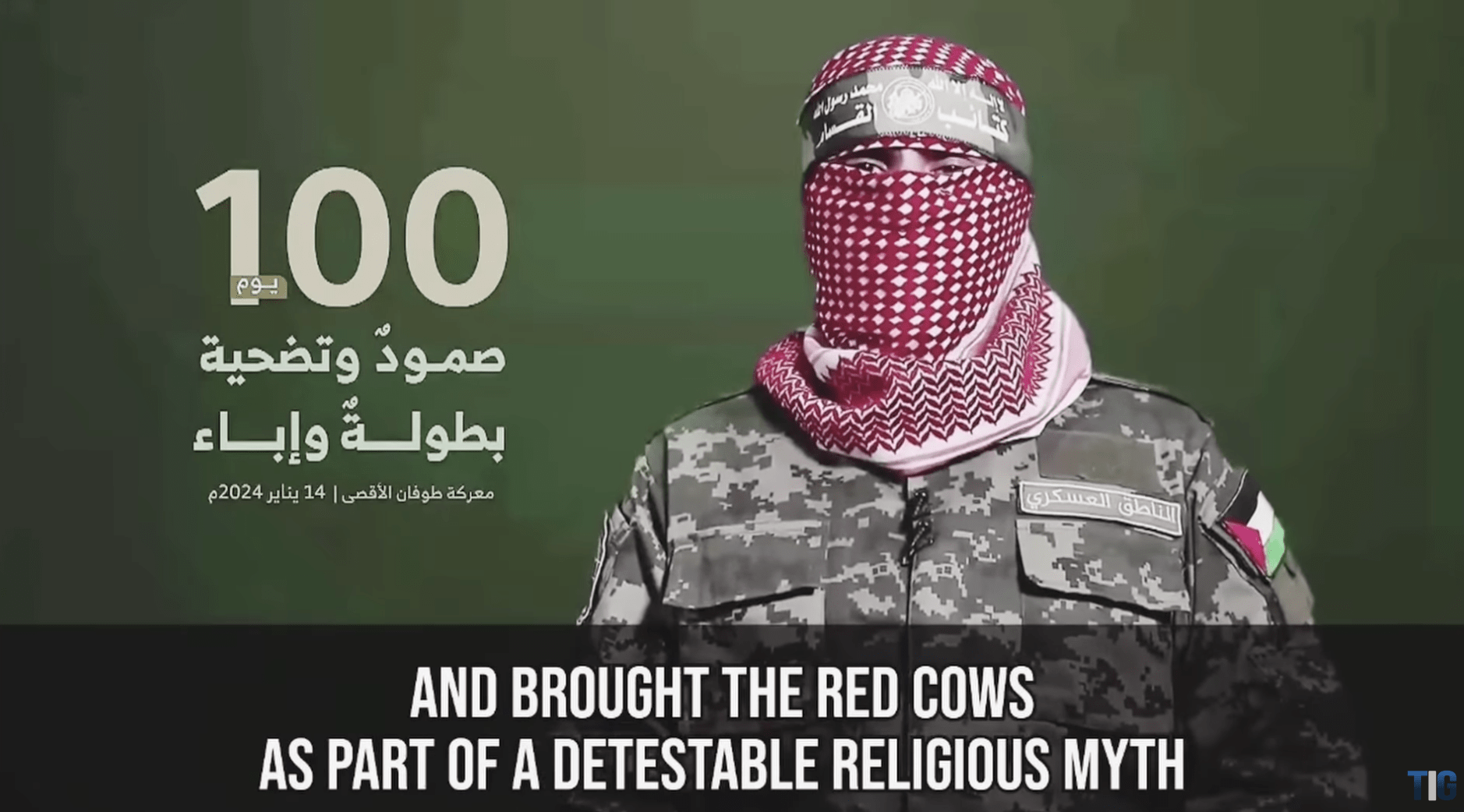 A spokesman from Hamas gave this speech, 100 days into the war precipitated by the massacre of October 7:
A spokesman from Hamas gave this speech, 100 days into the war precipitated by the massacre of October 7:
“We look back 100 days to remember the educated, the complicit, and the incapacitated among the world powers governed by the law of the jungle, reminding them of an aggression that reached its peak against our path (Al-Quds) and Al-Aqsa, with the start of its actual temporal and spatial division, and the bringing of red cows as an application of a detestable religious myth designed for aggression against the feelings of an entire nation in the heart of its Arab identity, and the path of its prophet (the Night Journey) and Ascension to heaven.”2
Yes, these red cows have hurt the feelings of Hamas apparently, and their presence has been interpreted as an intolerable act of aggression.
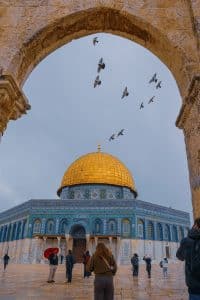 It must be remembered that the entire operation on October 7 was named “Al Aqsa Flood” (Al Aqsa being the grey-domed mosque on the Temple Mount). Like a red rag to a bull, news of the red heifers has signaled to the watching Islamic world that the Temple Mount might not be exclusively theirs forever. Concerns about the “desecration” of the Temple Mount plaza and the Al Aqsa mosque have been the cause of multiple outbreaks of violence, and this news is as incendiary as it gets.
It must be remembered that the entire operation on October 7 was named “Al Aqsa Flood” (Al Aqsa being the grey-domed mosque on the Temple Mount). Like a red rag to a bull, news of the red heifers has signaled to the watching Islamic world that the Temple Mount might not be exclusively theirs forever. Concerns about the “desecration” of the Temple Mount plaza and the Al Aqsa mosque have been the cause of multiple outbreaks of violence, and this news is as incendiary as it gets.
Very few Jewish people support the idea of deliberately doing away with the Muslim places of worship on the Temple Mount but many will cautiously assent to the belief that one day God Himself will bring about the third temple. How events will play out no one is quite sure. The Temple Institute are passionate about reinstating the sacrificial system, but not keen on Jesus. At all. However, we who do love Jesus can read in the New Testament that the antichrist will set up shop in that third temple towards the end, and that this abomination will only be done away with when the Messiah comes back to Jerusalem:
Let no one deceive you in any way. For that day will not come, unless the rebellion comes first, and the man of lawlessness is revealed, the son of destruction, who opposes and exalts himself against every so-called god or object of worship, so that he takes his seat in the temple of God, proclaiming himself to be God. Do you not remember that when I was still with you I told you these things? And you know what is restraining him now so that he may be revealed in his time. For the mystery of lawlessness is already at work. Only he who now restrains it will do so until he is out of the way. And then the lawless one will be revealed, whom the Lord Jesus will kill with the breath of his mouth and bring to nothing by the appearance of his coming. (2 Thessalonians 2:3-8)
What now?
So now we have apocalyptic cows causing trouble left and right: religious Jewish enthusiasts eagerly planning the third temple, furious terrorists groups resorting to extreme violence in their determination to thwart any possibility of such a thing, and misguided Christians all over the world lending their support to one side or the other… and a whole library of prophetic literature in all three traditions about what happens next. It’s hard to know how or when a third Jewish temple could appear, although there is enough room up on the Temple Mount to build a structure without destroying anything. Israel handed the Temple Mount over to Jordanian control when they conquered Jerusalem in 1967 in order to keep the peace, and there are no indications of a policy change any time soon. Time will tell how it all pans out. One thing’s for sure, the Temple Institute guys are ready and waiting, and the whole thing could be up and operational within months, if permission were ever to be granted. The only thing holding them back really, apart from a place to build, was the absence of red heifer ash. But that hurdle looks like it’s going to be overcome in the very near future.
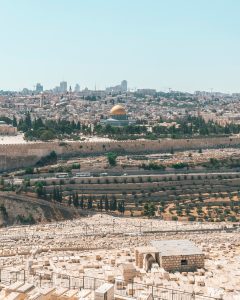
The third temple will be built, but it will also be desecrated, according to Scripture. However, at the end of this age, the Messiah will come and take His rightful place on the Temple Mount, on the throne of David:
For the yoke of his burden, and the staff for his shoulder, the rod of his oppressor, you have broken as on the day of Midian.
For every boot of the tramping warrior in battle tumult and every garment rolled in blood will be burned as fuel for the fire.
For to us a child is born, to us a son is given; and the government shall be upon his shoulder,
and his name shall be called Wonderful Counselor, Mighty God, Everlasting Father, Prince of Peace.
Of the increase of his government and of peace there will be no end, on the throne of David and over his kingdom, to establish it and to uphold it with justice and with righteousness from this time forth and forevermore.
The zeal of the Lord of hosts will do this. (Isaiah 9:4-7)
Satan knows his time is short. He is violently opposed to this plan, and is railing against it with all his might. But you cannot stop the Lord Almighty. Nothing can. In the meantime, we who love the Lord need to be thinking about preparing ourselves, and getting ready. What does that look like? We need to be getting rid of impurity in our lives, and rededicating ourselves to Him. When we read the passage about the red heifer in context, we see that it’s immediately followed by the death of Miriam and then water from the rock, and Moses’ sin of hitting that rock instead of speaking to it. This context gives us a clue as to what it all means for us today.
Rashi says the reason that Miriam’s death is juxtaposed with the red heifer is “To teach you that just as sacrifices bring atonement, so the death of the righteous secure atonement”. 3
The rabbis saw that the death of the righteous provides atonement.
These red heifers are symbolic of the perfect Messiah, an innocent sacrifice, whose death brings life.
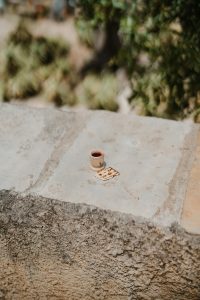 Our unrighteousness was put upon Him, and His righteousness is imparted to us when we wash ourselves in that living water, the water of purification from the ashes of sacrifice. The clues are all there… the hyssop harking back to the Passover blood on the doorframes, the scarlet thread of redemption which runs through the Scriptures, the perfect sacrifice without defect or flaw, the red color of blood, the death of the righteous which atones for sin, the priest made unclean and the unclean who are made clean by virtue of their service, and the water of purification which gives life… Moses getting the water from the rock reminds us not only how much we need that living water for survival, but also that obedience to the Lord is vital: Our striving to do unsanctioned good works don’t help. Just one word from Him is enough. If He has declared us clean, then that is what we are. Thank Him for His sacrifice that paid for your sin, and just believe. He has done it. One day, maybe someday soon, we will be able to thank Him face to face.
Our unrighteousness was put upon Him, and His righteousness is imparted to us when we wash ourselves in that living water, the water of purification from the ashes of sacrifice. The clues are all there… the hyssop harking back to the Passover blood on the doorframes, the scarlet thread of redemption which runs through the Scriptures, the perfect sacrifice without defect or flaw, the red color of blood, the death of the righteous which atones for sin, the priest made unclean and the unclean who are made clean by virtue of their service, and the water of purification which gives life… Moses getting the water from the rock reminds us not only how much we need that living water for survival, but also that obedience to the Lord is vital: Our striving to do unsanctioned good works don’t help. Just one word from Him is enough. If He has declared us clean, then that is what we are. Thank Him for His sacrifice that paid for your sin, and just believe. He has done it. One day, maybe someday soon, we will be able to thank Him face to face.
And since we have a great priest over the house of God, let us draw near with a true heart in full assurance of faith, with our hearts sprinkled clean from an evil conscience and our bodies washed with pure water. Let us hold fast the confession of our hope without wavering, for he who promised is faithful. (Hebrews 10:21-23)
- See Rashi on verse 12:9 and place them outside the camp: He divided it into three parts; one was put on the Mount of Olives, one was divided among all the watches, and one who put on the rampart surrounding the Temple area. The one given to the watches was outside the courtyard, allowing access to it for the inhabitants of outlying cities, whoever needed to purify himself. The one on the Mount of Olives was for the kohanim gedolim to sanctify themselves from it for use with other [red] cows. The one put on the rampart was kept as a keepsake by Scriptural ruling, as it says,”It shall be as a keepsake for the congregation of Israel. — [Sifrei Chukath 30, Parah 3:11 Tosefta Parah 3:8]
- The speech was translated into English by the Palestinian Chronicle.
- Rashi, Medieval rabbinic commentator, was referring to this explanation in the Talmud: “Even as the red heifer afforded atonement [by the ritual use of its ashes], so does the death of the righteous afford atonement [for the living they have left behind]”. (Mo’ed Katan 28a)
Photo by Jennifer Ermler on Unsplash

